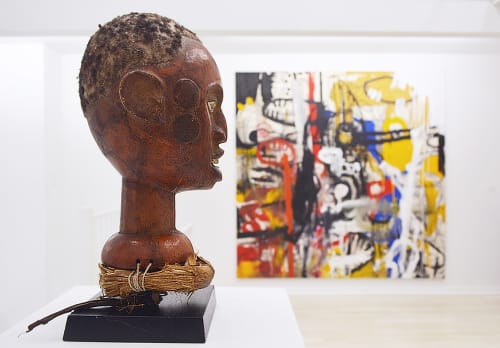FLAUNT: Africa New Wave
Ethan Cohen New York is pleased to present FLAUNT: Africa New Wave, a group exhibition featuring Aboudia, Pr.Adetomiwa A.Gbadebo, Armand Boua, Gresham Tapiwa Nyaude, Soly Cissé, Wycliffe Mundopa.
Almost a century ago, African art's interaction with the Western tradition changed the course of art history. From Picasso through Cubists to Brancusi, a spare austerity purged decoration from form and content thanks to the revelation of African minimalism. A new wave along the same vector is once again stirring the art world, born of a reverse-pollination as African artists absorb global esthetics and integrate them into their practice. Suddenly a lushness of color has appeared in paintings, almost psychedelic in stridency, drawing partly on polychrome tribal fabrics, sometimes on Western Pop-kitsch and flamboyance, to create a new unmistakably African synthesis. African art is globalizing and the world is paying attention. The Saatchi gallery has devoted the greater part of two shows – PANGAEA I and PANGAEA II – to the phenomenon. The African Art Fair has launched first in London, then in New York. Francois Pinot, the owner of Christies and a leading collector in the world, has invested heavily in the work of Aboudia. And the Cartier Foundation this summer presented a powerful African group show “Beaute Congo: 1926 - 2015”. Now Ethan Cohen New York is featuring a select group of such top African artists in “Flaunt: Africa New Wave”, part of an ongoing curatorial series of focusing on contemporary African art.
Wycliffe Mundopa
Born and residing in Zimbabwe, the 28 year old Wycliffe Mundopa allows garish, gaudy figures to forge out in a blaze of eroticized color-bursts. The figures are said to represent women of the night, demi-mondaines, their age and even gender rendered anonymous and universal in extroverted expressionist displays. In the striped stockings one sees the influence of Picasso's Harlequins and Pierrots, human toys, the external pleasure principle hiding inner identity. Elsewhere, from the intense primary tones and the gaudy wall-paperish backgrounds, one feels the presence of fin-de-siecle Paris and its preoccupation with the décor of sensuality.
Gresham Tapiwa Nyaude
Another young Zimbabwean artist, Nyaude's works are said to depict figures that populate the capital's most notorious ghetto, its animals and humans intermixed and compounded. Again the colors, hallucinatory and vibrant, come and go between background and foreground so the forms emerge from the whole expressionistically. Here one detects, too, the influence of Schiele and Klimt in the lush dissolution of form amid flecked patterns and draped shapes against the kind of luminous background colors that evoke the incursion of Japanese esthetics into Belle-epoque European painting.
Armand Boua
The Ivory Coast painter Boua's work was featured at the Saatchi gallery group show Pangaea II. Boua's embraces a contrary minimalism to convey his subjects, said to be abstracted forms of forgotten children lost in the violence of West Africa. They are isolated spare silhouettes outlined on found material like packing paper inked with tar set against jagged washes of color. Perhaps the most deeply felt humanist in his visual purpose, the power and austerity of his medium settles deeply on the mind. One senses he has seen the Western artists that early absorbed African symbolism from Odilon Redon to Giacometti and applies their lessons to haunting effect.
Pr. Adetomiwa A. Gbadebo
Gbadobo's is a Yoruba prince and his Nigerian heritage, his Afroprint chromatic sensibility, filters through Western forms of abstraction punctuated with drip-painting inflexions calling to mind the work of Paul Klee and Cy Twombly. Gbadebo utilizes that liberation from form to convey Yoruba spirituality and cultural music in kinetic rhythms. He is said to be concerned with ancestral guidance and the music of Fela Kuti. His bars of color and almost-realized figures reflect a pre-occupation with layers of consciousness as the predominant reality into which figuration dissolves.
Aboudia
Aboudia is one of the leading stars of the African New Wave. Practicing in his hometown of Abidjan, his work featured in the Saatchi gallery shows Pangaea 1 and Pangaea 2. He is collected by such leading collectors as Saatchi, Pinot and others. Ethan Cohen New York devoted a solo show to his paintings in April 2014.
Soly Cissé
Soly Cissé is a painter, draughtsman, and sculptor from Dakar, Senegal. His paintings are at once pictorial and graphic, rooted in the culture of his hometown, and loaded with autobiographical content. Cissé creates fantasy worlds where figures emerge from chaos and disharmony. His figures merge animal and human forms into strange, improbable hybrids wearing mortuary masks, as if they are deities of Cissé’s magical world. Linear patterns, checkerboards, and sequences of letters and numbers bring tension to his work, while also referencing both barcodes and mystical numerologies.





